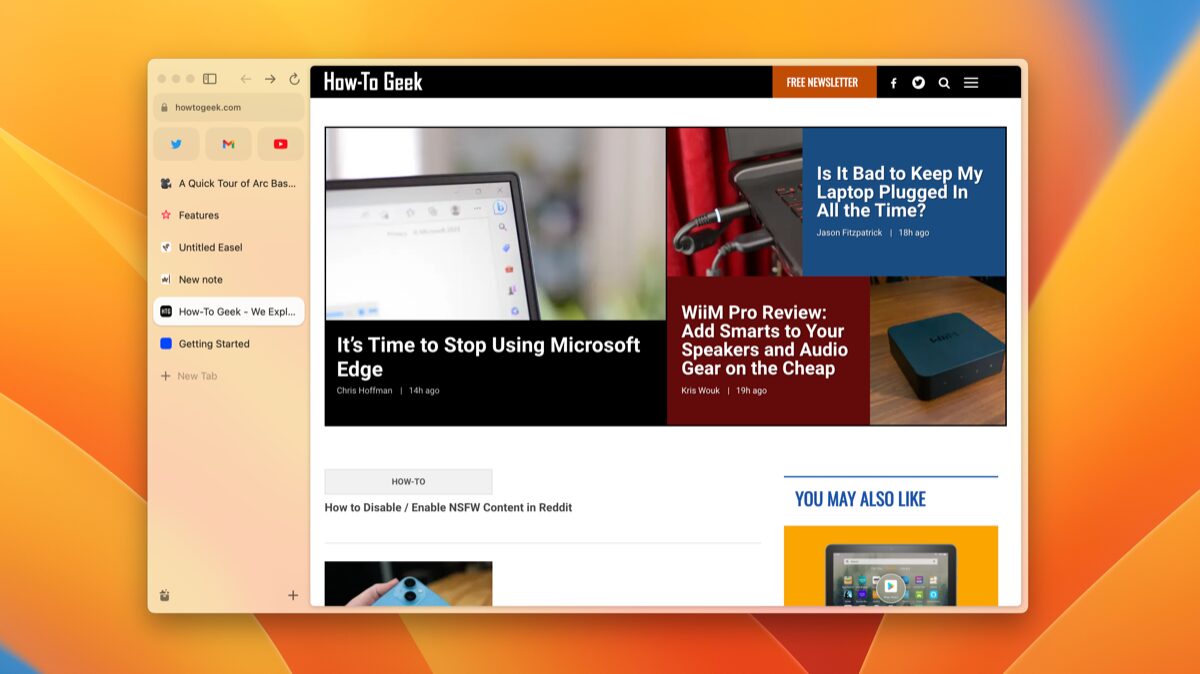5 Popular Linux Distributions and Who They’re Meant For
Are you tired of everyone recommending a new Linux distro claiming it’s the best? Are you wondering which one of these best distros is actually aligned with your needs and requirements? Well, let me spotlight five popular Linux distros and what they do, so you can finally make your choice!
I firmly believe that there’s no objectively best Linux distro, but there certainly is a Linux distro that’s subjectively best for you! The idea behind a Linux distro is to create an optimized Operating System catering to specific use cases. So, if a distro matches your use cases, it will be the best for you. Now, to help you find your match, I’ve narrowed down five popular Linux distros with a quick overview of their pros and cons. This should help you understand what each of these distros has to offer so you can pick the one that’s right for you!

Related
Here’s Why There Are So Many Linux Distros
Because the more the merrier.
5
Ubuntu
The name Ubuntu is almost synonymous with Linux these days and for good reason! It offers a stable and accessible user experience that’s not only user-friendly but also unique enough to feel like you’re using a new OS (Operating System). This is thanks to a customized version of the GNOME desktop environment which delivers a functional workflow focused around virtual desktops.
But one of the best things about Ubuntu is its Long Term Support (LTS) releases, which come out every two years and are supported for five years. This means you don’t need to worry about updating your OS anytime soon once you have settled in. That said, if you want to upgrade more frequently to access newer technologies, you still can by picking one of the non-LTS releases, which are released every six months with nine months of support.
Why You Should Consider Ubuntu
- Compatibility with almost all hardware—thanks to excellent out-of-the-box driver support.
- Access to a wide collection of software via Personal Package Archives (PPAs) and Snaps.
- AppArmor is enabled by default for enhanced security.
- Almost all Linux tutorials and guides use Ubuntu as an example, giving you access to tons of online resources.
Why Ubuntu Might Not Be Right for You
- It heavily pushes Snap packages, which are known to be slow and take up a lot of hard drive space.
- Not the most lightweight distro and can lag on old hardware.
- Lacks the some of the tools and customizability to appeal to Linux power users.
|
Best For |
|
|---|---|
|
Minimum Requirements |
|
|
Download Link |
Download Ubuntu Desktop |
4
Fedora
Fedora is another super-popular Linux distro that also uses GNOME—similar to Ubuntu—but ditches all the heavy customizations for a vanilla experience. The distro is also committed to delivering a cutting-edge user experience with new versions released every six months packed with all the latest software updates. That said, Fedora explicitly focuses on open-source software. You can run closed-source proprietary software if you like, but to do that, you’ll need to activate third-party repositories and might need to do some manual tinkering.
Why You Should Consider Fedora
- Comes with tons of developer tools out of the box, making it excellent for developers.
- Extremely stable despite the focus on delivering cutting-edge software.
- SELinux is enabled by default for enhanced security.
Why Fedora Might Not Be Right for You
- Each version is only supported for 13 months, forcing you to update more frequently.
- Certain services like Netflix won’t run out-of-the-box unless you manually install the proprietary media codecs and DRM modules.
|
Best For |
|
|---|---|
|
Minimum Requirements |
|
|
Download Link |
Download Fedora Workstation |

Related
Fedora vs. Ubuntu: Which Distro Is Right for You?
Ubuntu once was the go-to recommendation for beginners, but Fedora has closed the gap.
3
Linux Mint
Linux Mint is one of the top recommended distros for people new to Linux coming from Microsoft Windows. You get a Windows 7-like experience with a traditional desktop layout having a taskbar at the bottom, a Start button-like application menu to the left followed by all your pinned apps, and quick settings in the right corner. The distro is also optimized to be as beginner-friendly as possible, so you can focus on working with the OS instead of learning how the OS works.
Why You Should Consider Linux Mint
- Based on Ubuntu LTS, Linux Mint is an extremely stable and reliable Linux distro.
- It doesn’t include Snap apps, which many Linux users don’t like, and replaces them with Flatpaks.
- All the necessary codecs and drivers are installed out of the box.
Why Linux Mint Might Not Be Right for You
- The Windows 7-like appearance can feel a bit outdated.
- Being based on Ubuntu LTS, updates trail behind that of Ubuntu.
- Not the best choice if you are looking for powerful customization tools and in-depth system-level controls.
|
Best For |
|
|---|---|
|
Minimum Requirements |
|
|
Download Link |
Download Linux Mint |
2
Garuda Linux
Garuda Linux is relatively new on the Linux scene compared to the other distros on this list, but it has managed to gain a lot of attention and a loyal following. One of the biggest reasons behind its popularity is its bold and beautiful design. The Garuda Dragonized edition brings a KDE Plasma-based, macOS-inspired, neon-infused desktop with loud gamer vibes, while the Garuda Mokka edition keeps the same layout paired with a more muted pastel-based color scheme. That said, Garuda isn’t merely about the looks, as it packs in powerful graphical tools for system management that will rarely require you to use the terminal.
Why You Should Consider Garuda Linux
- Has built-in access to the Arch User Repository (AUR) which offers access to tens of thousands of software.
- The KDE Plasma desktop environment is super customizable.
- Implements tons of performance tweaks out-of-the-box that make it perfect for Linux gaming.
- It uses the Btrfs file system and Snapper, which help you create system snapshots and rollback to previous working states in case something breaks.
Why Garuda Linux Might Not Be Right for You
- It’s a demanding distro that can lag on weaker hardware.
- As a rolling release distro, you’ll need to update it weekly or bi-weekly to maintain optimal performance.
- Not ideal if you are completely new to Linux.
|
Best For |
|
|---|---|
|
Minimum Requirements |
|
|
Download Link |
Download Garuda Linux |

Related
Windows Gamers Should Try Out This Gaming-Focused Linux OS
Who doesn’t like dragons?
1
OpenSUSE
If you want a distro that can show you all the colors of Linux, you should go with OpenSUSE—after all, it’s the distro with a chameleon as its official mascot! OpenSUSE is available in both a rolling release version called Tumbleweed, and a stable release version called Leap. This means whether you want a more stable user experience or faster updates won’t require you to completely change distros and enter a new environment, but just switch to a different version of the same distro.
Furthermore, OpenSUSE supports all the popular desktop environments and lets you pick which one you want to use during the installation process. You get an almost vanilla experience with barely any theming or customization. The distro is also loaded with powerful tools like YaST, which makes it an excellent distro for system admins, but at the same time, it’s very user-friendly and something you can use on your home PC.
Why You Should Consider OpenSUSE
- Learn just how one distro works, and switch between different desktop environments or editions based on evolving needs without having to switch distros.
- OpenSUSE Tumbleweed is a rolling release distro, but updates go through testing before being pushing out, making the packages more stable compared to Garuda or other rolling release distros.
- Comes with YaST—a powerful tool that will help you manage almost all system administrative needs graphically, without using the terminal.
Why OpenSUSE Might Not Be Right for You
- YaST can be overwhelming and hard to navigate—with a layout similarly confusing as the Windows Control Panel.
- Default software availability on official repositories is not as vast, and you’ll need to use Flatpaks, Snaps, or AppImages.
|
Best For |
|
|---|---|
|
Minimum Requirements |
|
|
Download Link |
|

Related
Use Samba on Linux for Essential Home Network File Sharing: Here’s How
Sharing files across your home network is easy with Samba.
Which Distro Should You Choose?
If you’re new to Linux and are looking for a simple operating system for your day-to-day computing needs, both Ubuntu and Linux Mint are excellent options. Mint is slightly better if you are seeking something that feels familiar to Windows 7. That said, if you’re a developer or programmer, then Fedora is your best bet. It can be slightly technically demanding and require some terminal tinkering, but you should be able to handle this easily.
Coming to OpenSUSE, I’d recommend the Leap edition as a home server distro, especially thanks to YaST. And finally, we have Garuda Linux, which I’ll only recommend if you have some prior experience using Linux—unless you feel comfortable learning about Linux, reading wikis, and talking on forums to troubleshoot your issues. With zero knowledge of how Linux works, all the different features and options might overwhelm you, even if they are all graphical tools and not terminal-based.

Related
ChatGPT Helped Me Get Better at Using Linux, Here’s How
From explaining Linux commands to automating tasks, ChatGPT can handle them all.
How to Get Started
I hope you were able to pick your first distro based on the information above. The next step would be installing it on VirtualBox and testing it out. Some heavy distros like Garuda or Ubuntu can lag on VirtualBox, so you can try them by booting into the Live Environment. If you’re happy with the user experience, you can go ahead and install the distro on your PC.













